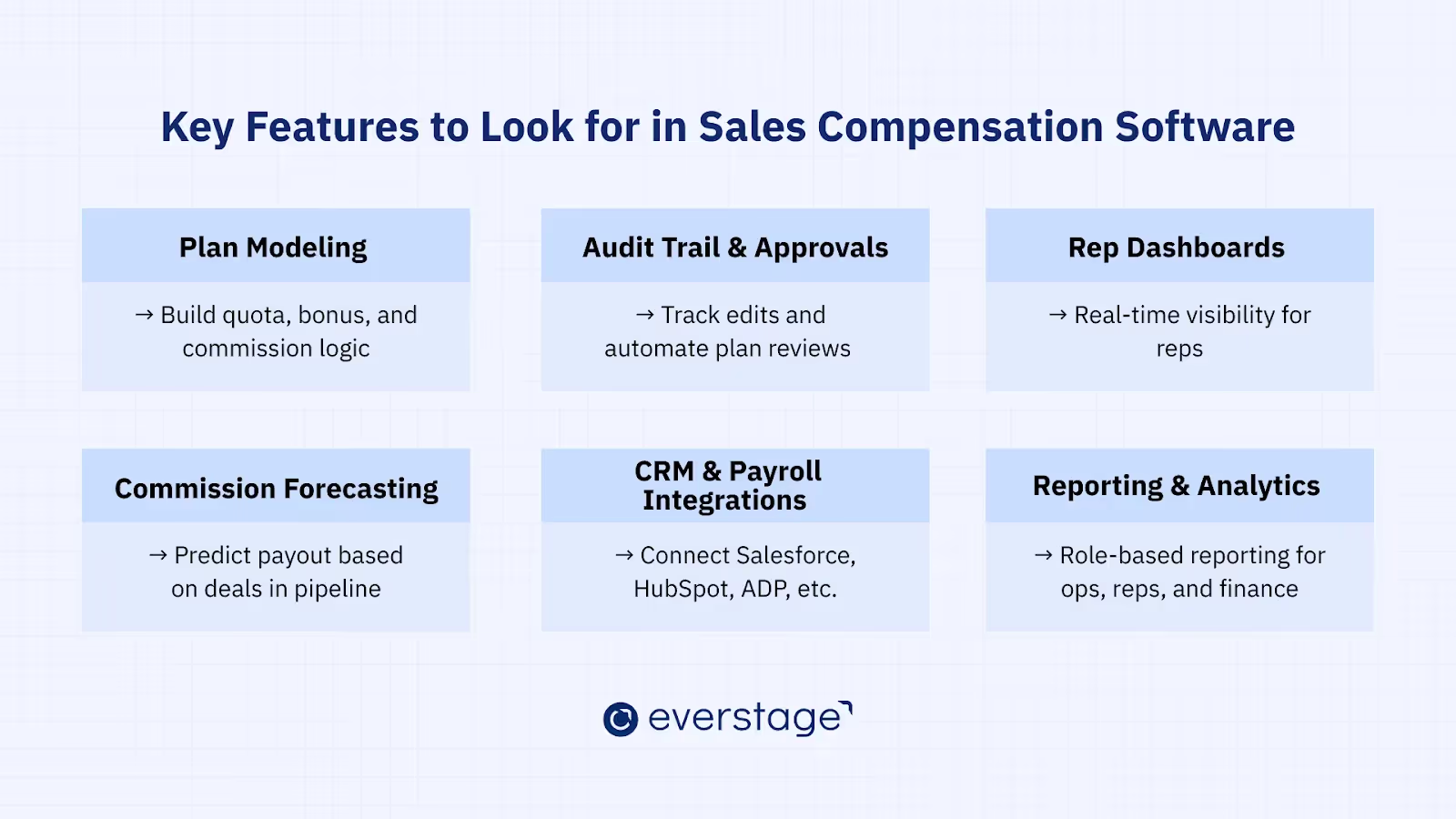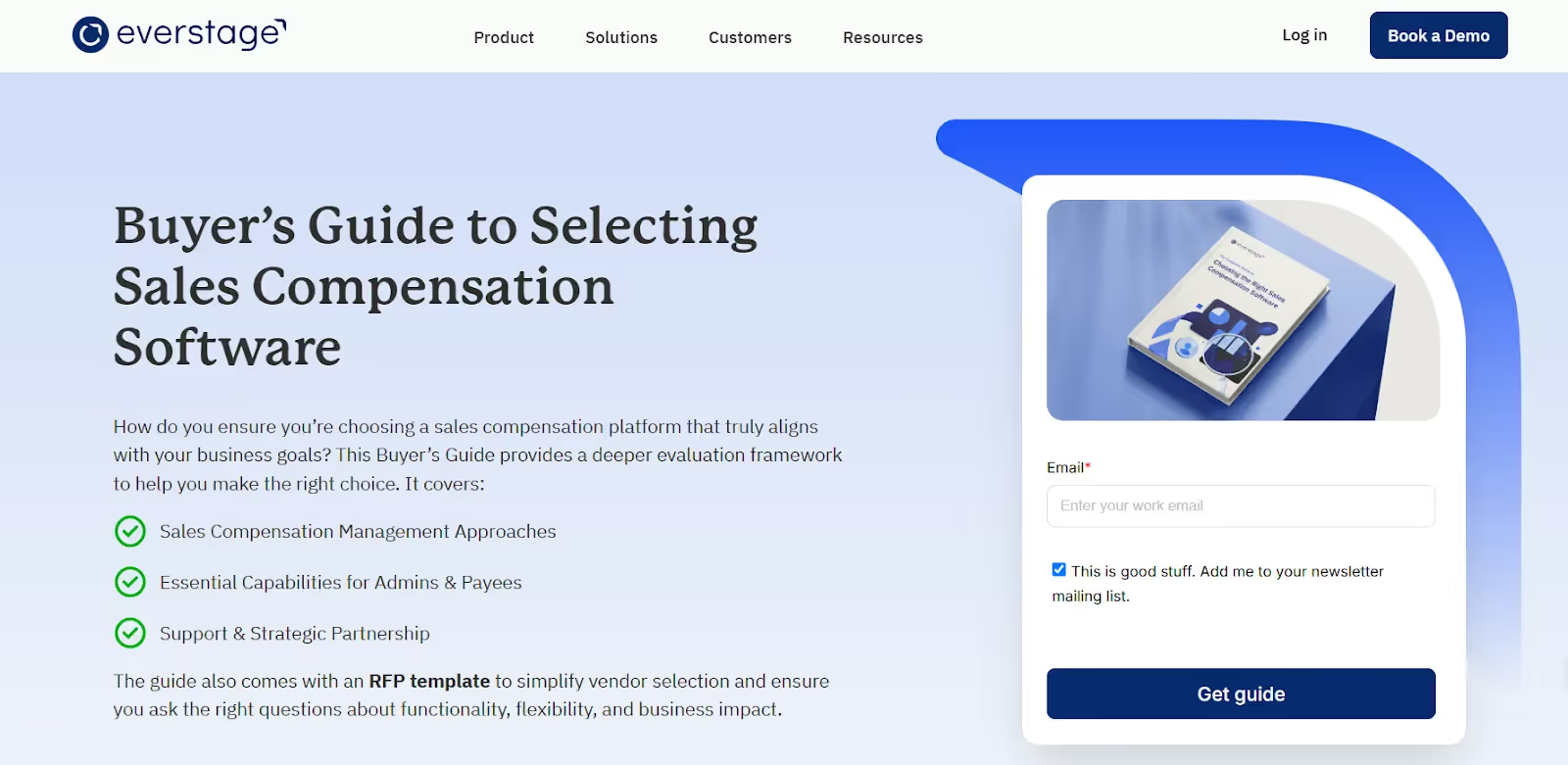Inside sales compensation software streamlines complex commission management for SaaS businesses, driving revenue growth and team motivation while reducing manual errors and inefficiencies.
- Eliminate confusion and boost sales performance by automating layered payout structures.
- Empower finance and sales ops with real-time, compliant, and scalable solutions.
- Leverage AI-driven modeling and predictive analytics for smarter, faster decision-making.
- Gain a competitive edge by adopting cloud-based tools that integrate seamlessly with CRMs.
Introduction
Sales compensation is one of those levers that quietly shape revenue outcomes. It can make your reps sell harder, smarter, or, if misaligned, leave them confused and unmotivated.
But as SaaS companies grow and compensation plans become more layered with accelerators, SPIFs, and MRR-based incentives, managing payouts via spreadsheets becomes a nightmare for finance teams, sales ops, and reps.
This is where sales compensation software comes in, not just as a tech upgrade, but as a growth enabler. Whether you're running a complex SaaS sales compensation model or navigating multi-region teams with different payout rules, automation helps you move faster, stay compliant, and keep your sales team engaged.
In this blog, we'll explore how the sales compensation software market is evolving, the trends reshaping it, and what the future holds with real-world data, uncover emerging technologies like AI-driven modeling, and highlight why early adopters are gaining a serious competitive edge.
Sales Compensation Software Market Overview
The sales compensation software market is growing rapidly as companies adopt automated platforms to manage commissions, track quotas, and improve payout accuracy.
Enterprises and high-growth teams use these tools to forecast earnings, align incentives with business goals, and scale compensation plans globally. Cloud-based, real-time solutions dominate the market, offering faster deployment, integration with CRMs, and transparent reporting.
Demand continues to rise with the shift toward digital sales operations, AI-driven forecasting, and hybrid workforce models. Market players compete on features like dynamic dashboards, plan modeling, and compliance automation.
In fact, according to a Future Market Insights report, the global sales compensation software market was valued at approximately $2.8 billion in 2023, and is projected to cross $7.4 billion by 2033, growing at a CAGR of 9.9%.
This growth is closely tied to the surge in commission automation, the evolving SaaS sales compensation model, and the broader transformation happening in sales performance management (SPM).
For businesses focused on agility, transparency, and data-driven sales operations, investing in modern sales commission platforms is a strategic revenue move.
Why the Sales Compensation Software Market is Gaining Momentum
Sales compensation management software has emerged as a critical tool to drive transparency, scalability, and real-time visibility for sales organizations in response to increasing operational complexity, changing seller expectations, and the rise of outcome-driven SaaS business models.
The following factors explain why adoption is accelerating.
1. The Shift from Spreadsheets to Automation
Many companies still rely on Excel to manage compensation which is time-consuming, error-prone, and almost impossible to audit at scale, making automation essential for error reduction. Manual updates lead to payout delays, calculation mistakes, and frustrated reps.
These software eliminates these inefficiencies and streamlines compensation processes with:
- Automated commission management workflows that reduce manual intervention
- Version control and audit trails that satisfy compliance and finance
- Centralized logic to update comp rules without touching every file
It’s not just about productivity. It’s about reclaiming trust and clarity in how reps are paid.
2. The Need for Real-Time Visibility & Accuracy
In modern sales teams, compensation visibility is expected. Reps want to know how much they’ve earned today, not at the end of the quarter. They also want transparency on how payouts are calculated.
This is where tools with real-time dashboards, estimated payout previews, and attainment tracking come in. By integrating with CRMs like Salesforce and HubSpot, these platforms provide:
- Live commission estimations
- Forecasted attainment vs. actual progress
- Clear alignment between performance and earnings
When sales reps can self-serve answers, sales ops can focus on higher-value work.
Platforms like Everstage with its reporting and analytics module gives sales teams real-time dashboards, forecast visibility, and rep-level transparency so every stakeholder can make informed decisions faster.
3. Faster Sales Team Expansion
With SaaS startups and scaleups hiring rapidly, managing compensation manually becomes a bottleneck. Whether onboarding 5 or 50 reps, time-to-productivity matters.
Sales compensation software supports fast scaling by:
- Using prebuilt plan templates for quick onboarding
- Assigning rules by role, territory, or product line
- Eliminating spreadsheet fatigue for managers and finance
It ensures growing teams don’t outpace the systems designed to support them.
4. Rising Compensation Plan Complexity
Modern sales plans are no longer just base + variable. They include:
- Accelerators for overachievement
- SPIFs for strategic pushes
- Multi-tiered quotas and draw programs
Each component introduces calculation complexity and audit risks. With a robust sales compensation model, teams can define logic once, simulate outcomes, and apply exceptions where needed, all within the software.
That’s how compensation evolves from a pain point into a performance lever.
Market Size & Forecast (2025–2034)
The sales compensation software market size is growing and maturing. As more companies modernize compensation structures, investment in scalable, intelligent solutions continues to rise across geographies and industries.
Here are few projections for forecast period 2025-2034:
Global Revenue & CAGR Projections
Multiple research firms project strong growth for this market over the next decade:
- Future Market Insights estimates the market was valued at $2.7 billion in 2023, with projections to reach $7.4 billion by 2033 at a CAGR of 9.9%.
- Verified Market Research reports a growth from $5.64 billion in 2023 to $11.25 billion by 2031, with a CAGR of 8.4%.
- Market Research Future forecasts a broader market jump, from $17.69 billion in 2025 to $41.63 billion by 2034, a CAGR of 9.97%.
These projections reflect rising enterprise adoption, international expansion of sales teams, and increasing compensation complexity.
Breakup by Deployment Type (Cloud vs. On-Premise)
Deployment preference is also shifting in favor of cloud platforms, especially for fast-moving, distributed sales teams:
- Cloud-based solutions now represent around 70% of the market share, driven by:
- Lower IT maintenance costs
- Faster onboarding and rollout
- Integration with CRMs, ERPs, and payroll tools
- Native support for remote and hybrid work models
- On-premise deployments are still relevant for:
- Finance-regulated sectors (e.g., banking, insurance)
- Organizations with strict data residency laws
- Companies that require complete on-site control
Despite niche demand for on-premise models, cloud solutions continue to dominate, thanks to their agility, cost efficiency, and deployment speed.

Key Segments Driving the Market
The growth of the sales compensation software market is being driven by diverse market segmentation, where each user segment has unique goals, limitations, and incentive structures.
Here’s how adoption differs across these key segments.
Large Enterprises vs. SMEs
Large enterprises operate in complex sales environments. Their compensation plans often span:
- Multiple geographies and currencies
- Tiered quota structures by territory, product, or segment
- Customized incentive logic for new business, upsells, and renewals
For these organizations, sales compensation software is essential for scale. It offers centralized governance, granular permissioning, and integration with CRMs like Salesforce and ERPs like Workday.
In contrast, SMEs approach compensation with speed and cost-efficiency in mind. Their needs include:
- Pre-built templates for quick plan rollout
- Easy onboarding for small sales teams with user-friendly platforms
- Budget-friendly pricing models with low IT dependency
That’s why vendors offering sales commission platforms with flexible tiers, usage-based pricing, and drag-and-drop rule engines are gaining popularity among smaller businesses.
Regardless of size, both groups are shifting away from spreadsheets not just for efficiency, but to drive rep trust, data accuracy, and better decision-making.
SaaS Sales Compensation Use Cases
The SaaS business model is uniquely complex when it comes to sales compensation. Traditional volume-based commissions don’t align with modern growth motions like:
- Freemium-to-paid conversions in PLG-led orgs
- Usage-based billing tied to consumption metrics
- Multi-year contracts with ramp-up, expansion, and NRR incentives
As a result, SaaS companies need sales compensation software that supports:
- Variable triggers beyond closed-won deals (e.g., product activation or ARR milestones)
- Plan modeling that adjusts commissions based on contract length or discount tiers
- Rep dashboards that connect inputs (pipeline, stage progression) to expected outputs (payouts)
These features make it easier to align comp plans with MRR growth, expansion revenue, and long-term customer value.
In short, if your revenue is recurring, your compensation strategy needs to be too and modern SaaS sales comp platforms are finally catching up to that reality.
Regional Outlook & Market Opportunities
While the global sales compensation software market is expanding steadily, regional nuances play a key role in adoption rates, growth drivers, and platform needs. This section breaks down how North America, Europe, and Asia Pacific are evolving and what market opportunities lie ahead.
North America (U.S. Driven Growth)
North America, particularly the United States, continues to dominate the sales compensation market, thanks to early cloud adoption and mature sales tech infrastructure. The region is also home to key players and leading vendors like Everstage.
According to the Verified Market Research report, this region’s growth is propelled by strong integration ecosystems with platforms like Salesforce and HubSpot, and a cultural emphasis on performance transparency.
Companies view compensation platforms not just as operational tools, but as strategic investments to align GTM teams and drive retention.
Europe (Germany, UK Growth Rates)
In Europe, software adoption is accelerating, led by compliance-conscious markets such as Germany and the UK. The need for GDPR-compliant systems, localized tax logic, and currency support has made flexibility a critical buying factor.
According to the FMI report, the European market is projected to reach over $1.6 billion by 2033. Enterprises are prioritizing secure, modular platforms that align with evolving labor laws and compensation governance frameworks.
Asia Pacific (India, China Expansion)
Asia Pacific is expected to witness the fastest market growth, with a projected value of $1.4 billion by 2033 per the software market report by FMI.
India’s rise as a SaaS export hub, coupled with increased digitization across China, Japan, Singapore, and Australia, is driving platform demand.
The expansion of U.S. and EU-based SaaS companies into APAC is also contributing to the need for scalable, compliant sales compensation systems tailored to local nuances.
Key Market Drivers
The rise of the sales comp software market is the result of deep shifts in how companies structure, manage, and scale revenue operations. Two major forces are driving this acceleration:
Digital Transformation in Sales Operations
Sales operations have evolved far beyond CRM management. Today, it's about orchestrating complex, multi-system workflows that span across enablement, territory planning, forecasting, and compensation.
As over 60% of sales organizations are consolidating their tech stacks, there's a push to replace spreadsheets and siloed tools with integrated, cloud-first platforms.
Here’s what’s changing:
- Sales comp software now integrates with Salesforce, HubSpot, Netsuite, and ADP
- Admin teams automate workflows for approvals, exceptions, and audit tracking
- Real-time syncing ensures reps and managers access up-to-date earning projections
As digital sales tools mature, sales comp platforms are becoming a critical control layer in managing rep performance and revenue risk.
Increasing Focus on Incentive Accuracy and Transparency
More than just a payout, reps today expect to understand how that payout was calculated. This shift toward transparency is being driven by:
- Quota-to-OTE ratio mapping, helping reps see earnings potential across deals
- Real-time dashboards that break down payout formulas
- In-app explanations that demystify clawbacks, accelerators, and SPIFs
And it’s working. Transparent comp plans and effective incentive compensation management are directly tied to improved trust and rep retention.
Companies that prioritize transparency in compensation design report higher sales productivity and improved rep retention by 12-15%. Accuracy is an operational goal and a driver of retention, motivation, and trust.
Challenges Hindering Market Growth
Despite strong momentum, adoption of sales compensation software still faces critical hurdles, particularly among risk-averse sectors and smaller businesses.
1. Concerns over Cloud Security & Data Compliance
As platforms handle sensitive compensation data like quotas, payouts, and performance metrics, cloud-based systems face scrutiny from compliance and IT teams. In industries like healthcare and finance, where regulations are strict, concerns about data breaches, privacy, and hosting regions delay adoption.
Frameworks like SOC2, HIPAA, and GDPR are essential but not always guaranteed. Lack of transparency in third-party data handling and regional storage remains a barrier to global expansion.
Vendors that prioritize security certifications and flexible data residency options are better positioned to build trust and grow market share.
2. Complexity in Implementation for SMEs
For many SMEs, the benefits of automation get overshadowed by the complexity of setup. Some software solutions are built for enterprise-scale functionality needs, featuring complex commission plan modeling, custom APIs, and long onboarding cycles.
Extended implementation timelines and ongoing admin needs are among the top reasons small businesses delay adoption. Many feel these platforms are more than what’s needed for simple sales incentive plans.
To solve this, vendors must streamline the experience with faster onboarding, modular pricing, and ready-to-use templates.
That’s exactly where Everstage’s commission processing engine stands out with drag-and-drop rule setup, prebuilt comp plan templates, and automated commission processing that makes it easy for SMEs as well as large enterprises to launch and scale without operational overhead.
Future Trends in the Sales Compensation Software Market
The sales compensation software market is being reshaped by tech advancements and trends in AI, data integration, and evolving go-to-market strategies.
1. AI & Predictive Modeling for Commission Forecasting
Compensation tools are moving from static reporting to dynamic, AI-powered modeling. These tools simulate outcomes in real time, helping leaders forecast payouts, test plan changes, and align incentives with pipeline movement. Predictive analytics is now a must-have for enterprise-grade performance planning.
2. Embedded Sales Analytics & Real-Time Dashboards
Today’s platforms embed dashboards that serve reps, RevOps, finance, and leadership equally. From forecasted payouts to attainment tracking, users access live insights without switching between tools.
Integrations with CRMs like Salesforce, HubSpot, and Workday create a unified data layer that connects compensation, forecasting, and performance in one view.
3. PLG-Friendly Compensation Models
Product-led companies need flexible commission structures. Reps drive adoption, expansion, and retention, so software must support usage-based logic, milestone triggers, strategic partnerships, and tiered rewards.
Modern sales compensation software is evolving to reflect this shift. More vendors are building role-specific models that align with customer lifecycle metrics such as NRR and churn, especially in low-touch SaaS environments.
How to Choose the Right Sales Compensation Software
Choosing the right sales comp software platform is about finding the right fit for your compensation strategy, tech stack, and internal capacity. Whether you're scaling a high-growth SaaS team or replacing legacy spreadsheets, here's what you should evaluate.
Key Features to Look For
Of all sales comp platforms, some are designed for finance-heavy control, while others cater to sales ops, HR, or RevOps use cases. The best tools strike a balance between usability, flexibility, and actionable insight.
When evaluating vendors, prioritize these core capabilities:
- Plan modeling & simulation: The ability to design, test, and refine comp plans using historical or forecasted data
- Dashboards & rep portals: Reps should see what they’ve earned, how it was calculated, and what’s next, all in real time
- Audit trails & approval workflows: Especially critical for finance and compliance teams managing high-value payouts
- Integration ecosystem: Look for native connectors with Salesforce, HubSpot, SAP, Oracle, Workday, ADP, and payroll systems
- Commission forecasting: Enables revenue teams to project compensation costs and quota attainment under different scenarios
- User onboarding and support: Fast setup and strong customer success can make or break adoption
These features directly impact payout accuracy, rep trust, and administrative efficiency.

Factors That Influence Total Cost of Ownership
Compensation software costs can vary significantly depending on how it's implemented and maintained.
Here are key variables to consider:
- Licensing model: Some charge per payee, others use revenue tiers or active plans as pricing triggers
- Setup and onboarding costs: Complex organizations may need custom rule logic, sandbox modeling, and implementation support
- Admin effort: The more flexible the plan design, the more you may need ongoing ops support or engineering hours
- Scalability: Pick a platform that can absorb new reps and territories without slowing calculations or piling on extra admin work
Understanding these drivers early helps prevent cost overruns and ensures your platform scales with your GTM strategy. Platforms like Everstage support this by combining scalable architecture with automation and flexible pricing that adapts as your team grows.
Download the Full Guide
Your starting point for choosing the right sales compensation software begins with clarity on features, pricing, and fit for your team’s needs. That’s why we created a comprehensive resource to help you evaluate solutions with confidence.
Download our Buyer’s Guide to Sales Compensation Software to explore:
- Complete framework to evaluate sales commission software
- A checklist of must-have features for admins and reps
- An RFP template to simplify vendor selection
- An ROI calculator to build a strong business case
- A 5-step guide to revamp your compensation plans
- Best practices for driving adoption and revenue outcomes
Whether you're a startup or a scaling enterprise evaluating vendors or building your internal business case, this guide will give you a head start.

Conclusion
The sales compensation software market is evolving rapidly with shifting market dynamics. As incentive plans become more layered and revenue teams lean into automation, spreadsheets can no longer keep up.
Modern platforms now help you optimize and align payouts with performance, reduce errors, and give your sales reps visibility into what they’ve earned when it matters.
At Everstage, we’ve built a compensation engine designed for scaling SaaS teams that’s flexible, transparent, and deeply integrated with your GTM stack.
If you’re rethinking your comp strategy for 2025, book a personalized demo and see how Everstage can support your team.
Frequently Asked Questions
What is the best sales compensation software in 2025?
The best sales compensation software in 2025 offers cloud-based deployment, real-time commission tracking, customizable plan modeling, and CRM integration. Top platforms like Everstage lead the market by delivering scalable, user-friendly solutions for enterprises and growth-stage companies.
How big is the sales compensation software market?
The global sales compensation software market was valued between $2.7 billion and $3.1 billion in 2023 and is projected to surpass $7.4 billion by 2033, growing at a CAGR of 8.9%–9.9%. Cloud-based solutions dominate with approximately 70% market share.
What features should I look for in a compensation management platform?
Key features to look for include real-time dashboards, custom rule engines, audit trails, integration with CRM and ERP systems, commission forecasting, onboarding support, and self-service configuration. Platforms should also offer compliance capabilities like SOC2 and GDPR alignment.
How does sales compensation software improve accuracy and payout speed?
Sales compensation software automates commission calculations, reduces spreadsheet errors, and offers real-time visibility into earnings. This automation increases payout accuracy, ensures compliance, and speeds up commission disbursements for sales teams.
What ROI can I expect from automating sales compensation?
Companies that adopt sales compensation software typically achieve faster onboarding, improved rep retention, reduced payout errors, and better quota attainment. These improvements contribute to significant cost savings and higher revenue scalability over time.
Are there real-time dashboards for reps to track performance?
Yes, leading sales compensation software platforms offer real-time dashboards. Reps can view their earnings, attainment against quotas, and payout estimations instantly, improving motivation, transparency, and trust.


.avif)


.avif)


